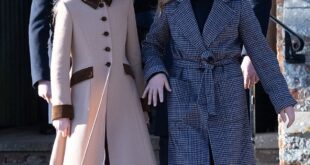Tony Tetro ranks among the world’s most talented art forgers — as Prince Charles found out the hard way.
Three borrowed paintings were loaned for display at Dumfries House, the Scottish estate that is headquarters to the Prince’s Fund charity. Uncannily done in the styles of Picasso, Dalí and Monet, the trio, according to the Daily Mail, was said to be valued at around $136 million.
In reality, Tetro told The Post, the combined value is more like $60,000. He would know. He claims he painted them and was paid to do it.
He makes it clear to buyers that he’s not masquerading his work, which he calls “emulations,” as the real deal. Which is why, when he heard of the Prince Charles scandal that was blasted across the British tabloids, Tetro set out to prove he wasn’t being underhanded.
“The news was a surprise to me,” the 69-year-old told The Post. “I traveled to England so I could nip this in the bud.”
Back in the 1980s, Tetro, who hails from Fulton, New York, created astonishing fakes that were passed off as authentic masterpieces: paintings that looked exactly like work by Rembrandt, Joan Miró and Mark Rothko. Tetro maintains that he never said they were originals. Regardless of his intentions, Tetro did seem to live up to a maxim credited to Picasso: “Good artists copy, great artists steal.”

Busted in 1988 by Los Angeles County investigators, Tetro served nine months in a work-release program after pleading no contest to forgery.
Now the knockoff artist has gone legit. He still creates works that look a hell of a lot like ones by Monet, Picasso and other famous names. He sells them directly to collectors rather than dealers.
Indeed, his work truly is good enough to fool royalty.
“He’s unbelievably skilled,” said LA-based collector Stefan Simchowitz. “Tony Tetro is one of the greatest forgers in history.”
Tetro, the son of a water-tank painter, said that he “enjoyed painting as a young man. It was a hobby for me before [it was] my career.”
Prior to becoming an art forger, he sold furniture and worked in the family business. But he never attended art school.
His reputation as an art-world fabricator began in the early 1970s. After reading the Clifford Irving book “Fake!” — a biography of Elmyr de Hory, once considered the world’s greatest forger of paintings — Tetro was inspired to try his hand at mimicking famous artists.
His first was a duped Modigliani drawing. “I showed it to Sotheby’s or Christie’s [with the intention of] wanting to see how good it was,” he said. “The guy there looked at it and said that it didn’t feel right. I said, ‘What an a-hole …’”
But Tetro took the criticism to heart and traveled to Florence, Italy, to learn from a professional copyist of Old Masters art.
“He taught me how to properly do flesh tone,” said Tetro. “It is the most important thing in Old Master paintings.”
Tetro can do Picasso and Rockwell. But could [they copy] one another in a convincing manner?
– Art dealer Tom Binder on copy artist Tony Tetro
By 1978, he was good enough to knock off the likes of Marc Chagall, Norman Rockwell and Andy Warhol — often with forged signatures.
Ready to test the waters, he hit the gallery circuit with a spiel. “I went around in flip-flops and shorts, brought my paintings [to dealers in Palm Springs] and claimed that my grandfather left them for me,” said Tetro.
He’s not sure that anyone really bought the act but insists that the opportunities were too alluring for some gallerists to pass up. “The dealers all screwed me,” Tetro said, not acknowledging that eventual buyers, likely believing the works were authentic, were also screwed. “They would give me $4,000 for a painting and sell it for $150,000.”
Santa Monica art dealer Tom Binder never bought work from Tetro but respects the copyist’s skills.
“He is beyond the talents he is reproducing,” said Binder. “Tony Tetro can do Picasso and Rockwell. But could Picasso and Rockwell do one another in a convincing manner?”
Things unraveled in 1988 when the watercolorist Hiro Yamagata happened to walk past a gallery in Beverly Hills where some of “his” work was hanging inside. Yamagata recognized the pieces for what they were and authorities were notified.
“I emulated 40 paintings and signed Yamagata’s name,” Tetro admitted. “The dealer gave me up to save himself. He got probation.” At the time of Tetro’s arrest, Los Angeles District Attorney Ira Reiner characterized him as “the single largest forger of artworks in America.”
Tetro’s first trial for forgery ended in a hung jury. By the time he was retried, the artist’s finances were precarious. He pleaded no contest and made the best of being behind bars: “They built a studio for me in the sheriff’s office and I taught children to paint murals about traffic safety.”
Once released, Tetro changed his modus operandi. Now, instead of creating work that, inadvertently or not, fools people, he makes clear that his creations are for aesthetic value only and not meant to be passed off as originals.
“How many people do you think specialize in this?” he said. “I don’t know anyone.”
The faked signatures are still in place. So whether buyers decide to tell their friends the works are real is up to them.
According to Judd Grossman, a Manhattan-based attorney who specializes in art-related law, “If you buy a work of art that everyone knows is a copy or done in an artist’s style and hang it up to trick your dinner guests, that is fine. But once you add the signature . . . I have a problem with it. There would be no legitimate reason to do that other than to deceive.”
Tetro claims that the law is on his side: “In my court case, they set a precedent by saying that the signature is an integral part of the painting.”
Indeed, the “Monet” that had been hanging at Prince Charles’ Dumfries House bears what appears to be the artist’s signature. According to the Daily Mail, some of those works were lent to the charity by James Stunt.
Tetro told The Post he met Stunt, the British former son-in-law of Formula One billionaire Bernie Ecclestone, in 2016. He claimed that the bullion dealer commissioned 11 paintings, including ones inspired by Picasso, Dalí and Monet. Tetro even made the creations look appropriately old. “I aged the [canvas] stretchers with umber and coffee,” he said.
According to the Daily Mail, Stunt loaned Tetro’s pieces to Prince Charles’ charity headquarters for a 10-year free lease. The paper also maintains that Stunt tried using these paintings, and others, “to borrow millions.”

A statement from the Prince’s Foundation says that the authenticity of the paintings is “now in doubt” and that they “are no longer on display.”
While Stunt declined to comment on the paintings, Jonathan Nelson, who claims to be his assistant, told The Post: “James has and continues to have a special relationship with HRH the Prince of Wales and the charities with which HRH is involved.” In a social media post, Stunt offered “huge apologies to the Prince of Wales” and said he would “never do anything to deceive” the “people at Dumfries House.”
After Tetro realized that his work was hanging at the prince’s estate, he was quick to let everyone know he never meant for his art to be portrayed as real.
“I went public about the paintings,” Tetro said.
“I don’t want anyone hurt by this, especially not Prince Charles. They think I am part of this conspiracy but I knew nothing about it. I’m too old for this s–t.”
Source link



